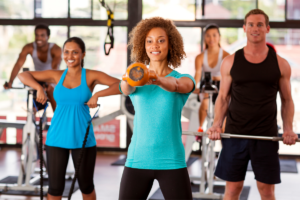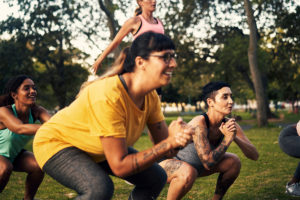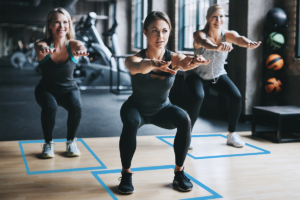Strength/Resistance
HIIT Cycling With a Side of Strength
A well-rounded program includes cardio and resistance training, so how do you bridge the gap? Try HIIT cycling with strength.
How To Create a Workout Community
As we return to the group exercise studio, it’s good to remember how a workout community not only brings us together, but helps us thrive.
Fit to Travel: Exercises for Seniors
Programming exercises for seniors is more important than ever, especially now that travel is opening up again, but your clients may not have kept up with their workouts over this last year. Here are some great ways to prepare your active agers for more adventure.
Sample Class: Park Workout
Take your boot camp class outside with this simple plug-and-play park workout, a mix of high-intensity cardio and lower-intensity resistance.
Sample Class: Tape-Box Workout
This fitness class with “tape box” workouts uses painter’s tape on the floor to create high-intensity agility and body-weight strength drills.
Sample Class: Slam It!
This exercise class utilizes sand bells, sandbags or slam balls and incorporates elements of strength, agility, core work and mobility.
Sample Class: Seated Exercises for Older Adults
Older adults are more susceptible to deficits in cardiovascular fitness, muscle mass, strength and power, which may ultimately lead to losses in physical function. The following chair-based format focuses on improving outcomes for older participants, especially those who may need the support of a chair during exercise. Ready, Set, Sit! offers the variety of three 15-minute training segments (cardiovascular, high intensity and strength/power), while targeting important components that boost overall function.
Muscular Strength and Mental Well-Being
In a study of midlife women in Singapore, weak upper- and lower-body strength was associated with depression and anxiety. Researchers analyzed data from 1,159 healthy women ages 45–69 for physical activity, physical performance, lifestyle choices, reproductive health, sociodemographic characteristics, and depression and anxiety symptoms. Weak handgrip strength and poor lower-body strength were associated with elevated symptoms of depression and/or anxiety. Fifteen percent of participants reported depression and/or anxiety.
High-Volume, High-Intensity Exercise Is Safe for Men
No need for concern about increased death risk from heart disease among experienced middle-aged exercisers who engage in high-intensity activity, at least if they’re male. Findings from a 10-year study of 21,758 generally healthy, very active men—like marathon runners, cyclists and swimmers—showed that even for those with higher coronary-artery calcium levels, athletic pursuits did not elevate risk of death.
Complex Training: Pairing for Power
If you work with athletes, you’ve likely run into the challenge of how to incorporate power components into their already-packed training schedules. Whether you’re working with a clutch outfielder, a center or a lineman, your client’s athletic skills need refinement, and power is one aspect that requires attention. Trainers typically program resistance training to develop strength and plyometric drills to improve speed.
Training Techniques for High-Performance Masters Athletes
Trainers and coaches can use examples of elite performances and aging research to develop training protocols for masters athletes.
Men’s Health Research Review
Men: Are you exercising and eating healthfully but not losing the weight you want? The good news is that there are more benefits to these two habits than just weight loss.
Megan Senger, professional fitness writer/editor and fitness instructor based in North Carolina, has summarized a few studies that center on men’s wellness, with comments on what the findings may mean for you.
The REAL Scoop on Protein Powders
Protein powders, especially the whey variety, have long been glorified in fitness circles for their muscle-building benefits. “Pump some iron and chug back a protein shake” is a preferred muscle-making formula.
Increase Neuromuscular Power for Your Athlete Clients
Competitive athletes often train for peak neuromuscular power to excel at the complex movements their sports require. Many personal training clients want to apply the same principle to their favorite sports.
With the right power training, fitness competitors can improve their tennis serve, golf swing, running speed, volleyball spike, soccer performance, basketball vertical jump and so on.
2019 IDEA® World Convention: Igniting Passion With Purpose!
Purpose, passion and people! The fitness industry is all about forging relationships that lift others up. Fitness professionals have energy to spare, and they are dedicated to mentoring new generations of pros, networking with peers, and motivating clients and participants every day.
Sample Class: EMOM Workout
If you enjoy teaching high-intensity classes, this fun, fast-moving and challenging EMOM workout is for you!
Women Need Protein, Too
For years we’ve heard that people who regularly lift weights can benefit from eating higher amounts of protein than the general population. There’s just one glaring problem. Most of the research behind this advice was conducted on men, with little focus on women. Now, a study in the April 2019 issue of Medicine & Science in Sports & Exercise has shed light on the specific protein needs of this understudied demographic.
Self-Selected or Fixed-Duration Rep Speed
A small study addressed the question of whether one gets better results from performing resistance training reps at a self-selected pace or at a fixed rep duration (2-second concentric phase, 2-second eccentric phase). Researchers from universities in S?úo Paolo recruited 12 resistance-trained men and evaluated exercise volume, muscle activation and time under tension.
Power Training vs. Strength Training for Older Adults
For maintaining functional ability—and potentially even for living longer—growing research
supports the benefits of power training, particularly as we age. Power is the ability to move weight with speed and to generate force and velocity with coordinated movement.
Winning Combination: Mindfulness and Strength
If you teach high-intensity classes, you may have noticed that many of your devoted students don’t take advantage of gentler options, such as restorative yoga, foam rolling or low-impact classes. Cross-training is necessary for peak fitness and reduced injury risk, yet persuading participants to try something new or different is not so easy. This class, Mindfulness and Strength, prioritizes mindfulness and flexibility.



















